Welcome to the world of bellydance. There is much to learn in this dance so take it slowly, one hip lift at a time. Be gentle with yourself. You probably have not been asked to move in these particular ways before. It does take practice and time for the nickel to drop. There are many approaches to learning bellydance and many styles to learn.
Delilah
Before we begin our first homework project, I would like to encourage you to join
Delilahs-Belly-Dance-Studio@Yahoogroups.com.
This group will keep you a breast of what’s happening at VDP Studio, with our teachers and fellow dancers, belly dance events around town, any last minute changes to the schedules, opportunities and once in a while a used costumes for sale. It’s the easiest way for us to stay in touch because it’s voluntary there is no spam issue. Sign up and get your mail as a digest so it will not clutter your e mail. Easy!
Powered by us.groups.yahoo.com
First Homework Project
If you are just beginning, I ask you to take a moment and write down what your impressions are of these questions:
- What is bellydance?
- How did you hear about it and first get interested in it?
- Do you know it by other names?
- Where does it come from?
Keep this paper in a notebook and in six months to a year add your new impressions and what you have come to discover, learn, and appreciate about the dance.
What I love about bellydance is its overall celebration of life and feminine freedom. The dance has structure and discipline, but the personality of the woman will define her individual style of presentation, a traditional fact about this dance. It is an art form rather than a typical folk dance. It’s a fabulous vehicle for personal expression, a dance that fuses together the elements of its environment as well as being molded by them: music, language, customs, politics, history and climate. Today’s world is hot for bellydance and it has never been more diverse in its stylization. Women bellydance all over the world (as do a few men).
Another thing you should know about bellydance is the personal transformation that women undergo when they begin. Yes, it’s a dance, but because you learn to have independent control over your own body you also learn to have more control in your life. Look out! Things may begin to change dramatically in your life!
I’m providing you with a few drawings as reference materials to add to your understanding of the basic body alignment used to execute clear bellydance isolations. You need to practice a little each day, instilling the new concepts in your body and mind. Even a moment’s meditation about the concepts will do you good. If you need more of a guided workout during the week to reinforce this new alignment process I recommend you buy “Absolute Beginning Belly Dance with Delilah” on video or DVD and use it a few times a week.
What to wear
- Soft comfortable attire!
- Nothing binding around your belly, not even elastic
- Hip scarf and/or belt to wear firmly on your hips
- Bare feet, usually
- Leotards or tights, or long skirt and a sports bra, or a long shift called a baladi dress with a hip scarf, all are fine
How to stand
- Stand with your feet, inside shoulders width/distance apart
- Bend your knees
- Drop your shoulders down
- Open your rib cage
- Tuck your lower back slightly and bring your hips forward so that if you place your index finger of each hand on the front of your hip bones, and then bring your thumb straight up it would touch the front of your rib cage
- Hold your arms out like you were reaching around a giant redwood tree
- Hold your head so your jaw is level and avoid looking down
- Imagine you have a book on your head
Your Personal Practice Approach: decide on a goal
A) Recreational Dancer: taking classes for fun and sisterhood.
Review and practice 20 to 45 minutes 2 days a week other than class. Should invest in simple practice costumes, perhaps a weight belt and enjoy.
B) Serious Hobbyist: using bellydancing for fitness, creativity and challenge and wants to do light performance and maybe teach eventually.
Use it as a daily workout. Practice and read lots of books, magazines and the Internet about bellydance. Attend big bellydance festivals and take notes. Watch instructional and performance videos. Buy and make costumes.
C) Hot Shot Professional Bellydancer: wants bellydance offered in universities and added to the Olympics!
Take a couple classes or workshops a week. Practice 2 hours a day and watch lots of videos and live performances. Learn to play the drum and finger cymbals. Invest in all kinds of CDs. Enter contests so it puts the pressure on to dance. Lift weights, do yoga and swim or do aerobics. Decide personal goals and take private classes. Start collecting costumes, artifacts and props.
Suggested learning tools
- Hip scarf with coins, beads, or bells so you can coordinate the sound of rhythm with movement. Tassels or fringe help feel the delayed line of your dance moves.
- Coin bra so you can tell if you are isolating top half of your body from the lower half of your body.
- Belly Dance Weight Belt for increasing strength and muscle memory.
- A stretchy little panty girdle folded down so it rides on your hips will help you feel how you shift your weight and control your hips and buttocks.
- Costumes are gear! What you wear helps you enjoy the dance as well as understand the delayed lines and actions of rhythm in space and motion.
- Absolute Beginning Belly Dance Workshop DVD as a training tool.
From Delilah’s “Drawing from the Right side of your Navel” © Copyright 2001
As a lesson, take a pencil and paper and draw these drawings for yourself to help obtain a thorough understanding.
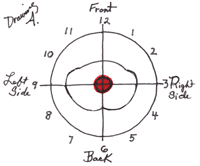 A.) Mapping the Internal Realms of the Body
A.) Mapping the Internal Realms of the Body
This is the basic map we use in the exercise workout. Visualize this pattern as an overhead view. The curvy shape represents your hips, buttocks and belly facing forward. The numbers of a clock face are included so you can orient and focus. The red inner circle represents a cross section of the core/pole that runs up and down your body. At the point where the lines intersect is your absolute center. Imagine it coming up from the core of the earth into your body and extending out of the top of your head. Imagine it is a magnetic core that your center of balance is continually drawn back to. When you purposely move your hips away to create an isolation pattern, they will return to that basic alignment eventually.
B.) Figure Eight Forward and Backward
This is a figure eight pattern drawn with the hips parallel to the floor (PTF). You will find all sorts of patterns like these taught and demonstrated on Delilah’s Belly Dance Workshop Volume I.
Orient yourself so you know where front and back are. Then note the arrows to the side. They indicate the directional thrust of the drawing for two different exercises.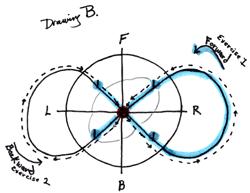
Exercise 1. The blue line is the forward figure eight. The four tick marks inside the circle represent the diagonal alignment of your hips at the junctions of the farthest twisting position. The torso shape is where you will end up after completing the right side of a forward figure eight. The left side is not colored, however, you are to proceed with your drawing slowly shifting your weight through the center. Imagine you have a pencil in each hip. You are going to draw each loop of the eight with each hip. First work with one hip, then transfer the energy through the inside of your body crossing through the center core into the other hip and draw the other side. Repeat continuously.
Start slow to a cheftitelli rhythm (see music recommendations). Bend your knees and keep your nose, chin and sternum facing center front. Your weight will be on the balls of your feet for a forward eight. You will feel lots of twisting going on in the torso when you articulate this pattern. Note how good it feels and focus on your potential for growing stronger!
Exercise 2. Reverse the direction with your weight more on the heels for a backward eight. Strive to keep your hip down and the drawing parallel to the floor in both these movements.
Note the emotional difference between the forward figure eight and the backward figure eight.
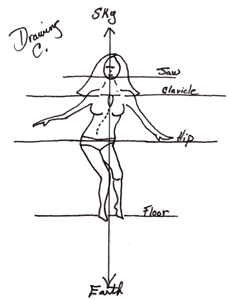 C.) Hip Slide to the Side
C.) Hip Slide to the Side
In the Absolute Beginning program I give you an exercise of a straight across hip slide to the side. Bend your knees and sit on an imaginary trapeze bar. Slide your buttocks over the bar without lifting at the side. Keep your cheeks on the bar. I use the image of a child’s Etch-A-Sketch in that you have two controls you are operating at once. Your hip is going to the side, but you are pushing or drawing it down at the same time to keep it PTF.
Note the core pole line in the drawing. The hips have left that alignment but the sternum, clavicle, chin, feet and knees have not. The only way this can be accomplished is if there is plenty of slack built into the body with the bent knees, the use of the ankles and balls of the feet, and the tuck of the pelvis in basic alignment.
D.) The Wedge Exercise
In this drawing I’ve included a hip belt to signify the hips. This exercise is meant to teach dancers the difference between a hip slide and a hip rotation.
Bend your knees and keep your core alignment intact.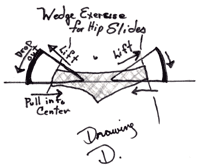
- Begin by rotating your hips up and out toward the rib cage.
- Drop the hip down and out.
- Slide it back in then do the same on the other side.
Repeat slowly and for additional exercises you can add speed and reverse the direction. All are very important.
The benefit to the dancer is an expanding awareness about the intricate mechanisms of her movements’ range and possibilities and the ability to distinguish between the moves.
E.) The Hour Glass Shape
Practice drawing an hour glass shape until you have a good grasp in your mind what it is.
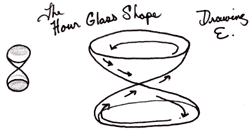
F.) Simple Hip Patterns
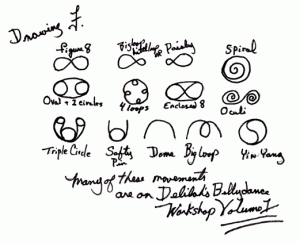
G.) Exercise Grid
- Practice drawing these shapes and any other shapes that come to you on a piece of paper.
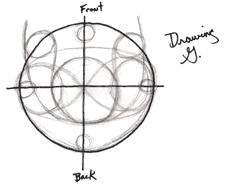
- Then draw a circle with a cross through it with a pen. Use this as a grid. Then with a pencil draw the shapes over your grid and study where the balance point would be in relationship to the figure and your body.
- Experiment with the size of the shapes.
- Think of the big loop little loop or Paisley drawn with one hip only. See what you come up with.
Experienced Bellydancers
How to plan a workout:
Preliminary warm up
- Bend your knees, establish basic alignment and walk around the block, the house or the studio for 5 minutes.
- Look within and engage your dance character
- Focus on the process of your breath
- Ground and center your weight and balance
Ritual Warm up
- Create your own Ritual Warm up or use mine from Delilah’s Belly Dance Workshop Volume I. Include full body stretching, strengthening, conditioning with conscious breathing and mindful repetitions.
Study Workout
- Review bellydance steps and combinations to different musical selections
- Work out by dancing to a 3, 5, or 7 part routine
- Stamina Challenge. Maintain a power shimmy for 60 second for a few days then move it up to 90 seconds and increase as you get stronger.
- Work out with a veil every practice session for good cardiovascular health.
Studio Rental
For serious dance, practice on your own. VDP Studios has just installed an HD DVD TV player, and is now available to rent out to dancers wishing to work out to DVDs. You can watch any of the Visionary Dance Production programs on DVD or bring any other program from your own home library, and take advantage of the 800 square foot studio space and sound system. COST: $15 per hour, videos included. $5 extra hours and extra dancers.

